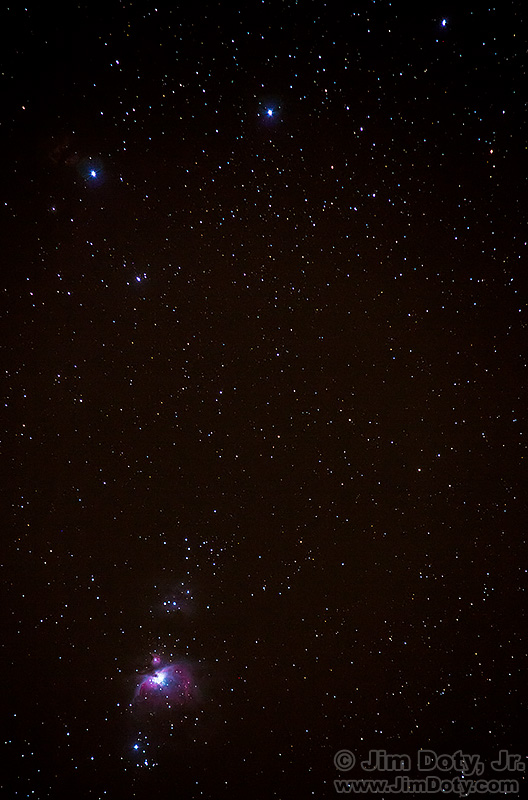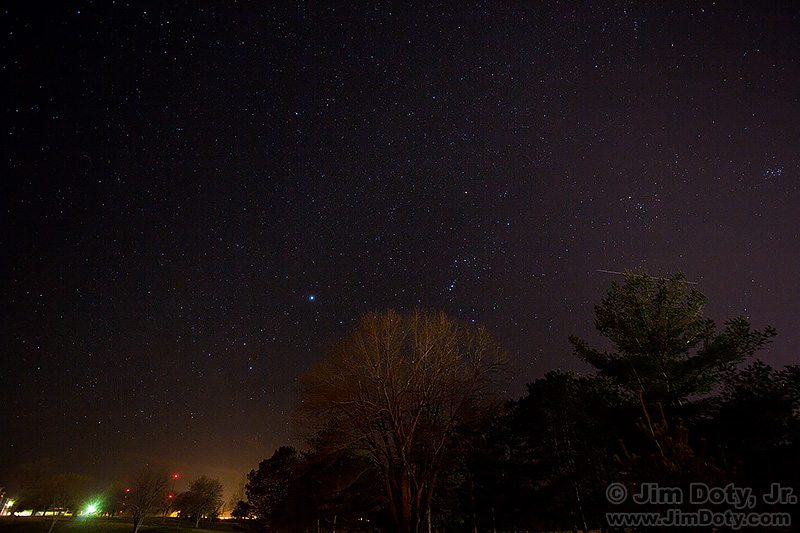
Orion’s belt, sword and the Orion Nebula in the middle of the sword. 300mm focal length lens and camera mounted on an iOptron Sky Tracker.
Using a tripod, camera, and lens you already own, am iOptron Sky Tracker allows you to take photos that would be impossible with just a camera and tripod. This is a first look at my first night using an iOptron Sky Tracker and ball head. Details will follow later.
Posted March 11, 2016. Updated Dec. 5, 2017.
I am star deprived thanks to living in central Ohio where the 15th largest city in the United State casts its light into the night sky. So a trip to a small rural Iowa community gave me a chance at a much needed dose of star light, plus a chance to try my iOptron SkyTracker for the first time. I left the rainy weather in Ohio and arrived in Iowa last night with a clear sky and bright stars. Perfect for my first test.
After a couple of photos with 17mm wide angle lens just to make sure everything was working correctly (photo below), I put a 70-300mm lens on my camera to give the Star Tracker a real test. I went right for the 300mm focal length right off the bat.

My first photo using an iOptron Sky Tracker and ball head. Orion, Canis Major, Sirius, Taurus, Hyades, and Pleiades. Orion’s belt and sword are just above the bare tree in the middle of the photo. 17mm focal length lens and camera. Click to see a larger version.
Thanks to the rotation of the earth, stars begin to trail in photos taken with a tripod mounted camera. The purpose of a Sky Tracker is to compensates for the motion of the earth and give you longer shutter speeds which will reveal more of the night sky.
The “Rule of 500” is a nice estimate for the longest shutter speed you can use with a tripod mounted camera and not have excessive star trailing. Just divide 500 by the lens focal length you are using and that will give you the answer in seconds. With a super wide angle lens (17mm) the limit is about 30 seconds (500 divided by 17). At 100mm, stars begin to trail excessively at 5 seconds (500/100). At 300mm, stars begin to trail at 1-2 seconds. A 300mm focal length would be a real test for the Sky Tracker.
The iOptron StarTracker did very well with the 300mm lens, giving me nice photos at 60 seconds, as you can see from the photo at the top of this article. The only problem I encountered was aberrations caused by the lens. Every lens has optical aberrations and they are most obvious at wide apertures and they really show up when doing astrophotography. The stars are warped as you move away from the center of the frame. The better your lens, the better your night sky photo will be.
I did a fast edit of these photos on my laptop to use in this article. I don’t fully trust laptop screens so I will do a final edit when I get home to my desktop computer and color calibrated monitor.
The iOptron ball head is quite inexpensive as quality ball heads go. It was was more than adequate for holding the camera and 70-300mm lens combination.
The two big challenges I faced last night were accurate focus on the stars and correctly aligning the polar scope of the Star Tracker. I will cover both of these challenges and provide some tips in a follow up article.
In short, after last night’s initial test I am very pleased with the iOptron Sky Tracker and ball head.
More information at the links below.
Photo Data
Top image: Canon 5D Mark III. Canon EF 70-300mm DO lens at 300mm. f/8, 62 seconds, ISO 800. Camera and lens mounted on an iOptron Sky Tracker.
Bottom image: Canon 5D Mark III. Canon EF 17-40mm f/4 lens at 17mm. f/5.6, 30 seconds, ISO 400. Camera and lens mounted on an iOptron Sky Tracker.
Series Links
“How To†Series: Astrophotography with the iOptron SkyTracker – series overview
iOptron Sky Tracker and Ball Head
First Night: Testing an iOptron Sky Tracker, Part One
First Night: Testing an iOptron Sky Tracker, Part Two
iOptron Polar Scope Alignment with a Simple Chart
Related Links
The Best Night, Astronomy, and Astrophotography Books
How To Get Critical Focus in “Live View†Mode with a Magnified Image
Tripod Recommendations: The Best of the Best
Tripod Head Recommendations: Some of the Best of the Best
Purchase Links
The iOptron Astrophotography Gear section of my photography store has iOptron equipment and planispheres. The books section of my photography store has a selection of The Best Night, Astronomy, and Astrophotography Books. My photography store has direct links to Amazon.com so you get Amazon’s great prices, fast delivery, and excellent guarantee.
Buyer’s Guide Series Link
This is one in a series of articles that will guide you to the best of all things photographic. The rest of the series is here: Buyer’s Guide: Recommendations For The Best Photography Equipment, Software, Books, Magazines, DVDs, Online Photo Labs and More.
Web Site Links
iOptron – all products
